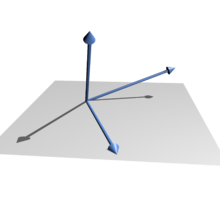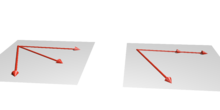Linear independence
In linear algebra, a family of vectors of a vector space is called linearly independent if the zero vector can only be generated by a linear combination of the vectors in which all coefficients of the combination are set to the value zero. Equivalently (unless the family consists only of the zero vector), none of the vectors can be represented as a linear combination of the other vectors in the family.
Otherwise they are called linearly dependent. In this case, at least one of the vectors (but not necessarily each) can be represented as a linear combination of the others.
For example, in the three-dimensional Euclidean space 










Linear independent vectors in ℝ3

Linear dependent vectors in a plane in ℝ3
Definition
Let 




A finite family 

with coefficients 


The family 


The zero vector 


The term is also used for subsets of a vector space: A subset 





Other characterisations and simple properties
- The vectors
are (unless
and
) are linearly independent exactly when none of them can be represented as a linear combination of the others.
This statement does not apply in the more general context of moduli over rings.
- A variant of this statement is the dependence lemma: If
are linearly independent and
linearly dependent, then
as a linear combination of
.
- If a family of vectors is linearly independent, then each subfamily of this family is also linearly independent. If, on the other hand, a family is linearly dependent, then every family that contains this dependent family is also linearly dependent.
- Elementary transformations of the vectors do not change the linear dependence or the linear independence.
- If the zero vector is one of the
(here: let
), they are linearly dependent - the zero vector can be generated by
setting all except for
which, as a coefficient of the zero vector
may be arbitrary (i.e. in particular also non-zero).
- In a
-dimensional space, a family of more than
vectors is always linearly dependent (see barrier lemma).
Determination by means of determinant
If one has given 



Basis of a vector space
→ Main article: Basis (vector space)
The concept of linearly independent vectors plays an important role in the definition and handling of vector space bases. A base of a vector space is a linearly independent generating system. Bases make it possible to calculate with coordinates, especially for finite-dimensional vector spaces.
Examples
Single vector




For it follows from the definition of the vector space that if


can only be 

Vectors in the plane
The vectors 


Proof: For 
i.e.
Then applies
so
This system of equations is only valid for the solution 



Standard basis in n-dimensional space
In the vector space 

Then the vector family 

Proof: For 
But then also
and it follows that 

Functions as vectors
Let be 




Proof: Let 
for all 

By subtracting the first equation from the second equation, we obtain
Since this equation must hold




It follows again that (for 

Since the first equation is only solvable for 



See also: Wronski determinant
Rows
Let be 

but nevertheless are 


Rows and columns of a matrix
Another interesting question is whether the rows of a matrix are linearly independent or not. Here, the rows are regarded as vectors. If the rows of a square matrix are linearly independent, the matrix is called regular, otherwise singular. The columns of a square matrix are linearly independent exactly when the rows are linearly independent. Example of a sequence of regular matrices: Hilbert matrix.
Rational independence
Real numbers that are linearly independent over the rational numbers as coefficients are called rationally independent or incommensurable. The numbers 

Generalisations
The definition of linearly independent vectors can be applied analogously to elements of a module. In this context, linearly independent families are also called free (see also: free module).
The notion of linear independence can be further generalised to a consideration of independent sets, see Matroid.
Search within the encyclopedia


















